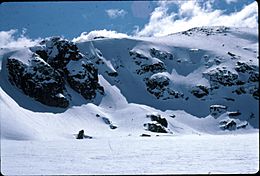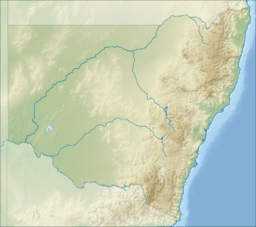Blue Lake (New South Wales) facts for kids
Quick facts for kids Blue Lake |
|
|---|---|

Frozen Blue Lake
|
|
| Location | Snowy Mountains, New South Wales |
| Coordinates | 36°24′13″S 148°18′54″E / 36.40361°S 148.31500°E |
| Type | Glacial cirque |
| Primary inflows | Snowmelt |
| River sources | Blue Lake Creek |
| Basin countries | Australia |
| Designation |
|
| Surface area | 16 ha (40 acres) |
| Max. depth | 28 m (92 ft) |
| Surface elevation | 1,890 m (6,200 ft) AHD |
| Frozen | June–September |
| Designated: | 17 March 1996 |
| Reference #: | 800 |
The Blue Lake is a special type of lake found in the Snowy Mountains of New South Wales, Australia. It is one of only four "cirque lakes" on mainland Australia. A cirque lake is a lake that sits in a bowl-shaped valley carved out by a glacier (a huge, slow-moving river of ice).
Blue Lake is known for having the best examples of features left behind by glaciers in the Kosciuszko National Park area. Because it is so important, a large area around the lake was named a "Ramsar Site" on March 17, 1996. This means it is a wetland that is important for the whole world. The lake is part of the Australian Alps National Parks and Reserves.
Contents
What is Blue Lake Like?
Blue Lake covers an area of about 16 hectares (that's like 20 football fields!). It is also quite deep, reaching about 28 metres at its deepest point. The lake's surface is open water, with large rocks along some of its edges and smaller pebbles along others.
You can find Blue Lake about 28 kilometres west of Jindabyne. It sits high up in the mountains, at an altitude of 1890 metres above sea level. This area was shaped by ancient glaciers.
How Blue Lake Was Formed
Blue Lake was created thousands of years ago. Huge glaciers flowed down from the Great Dividing Range. As they moved, they slowly carved out a deep, bowl-shaped basin in the hard granite rock. This basin then filled with water to become the lake we see today.
The lake gets its water from snowmelt (melting snow) and from a stream called Blue Lake Creek, which starts near Mount Twynam. The surface of Blue Lake freezes over for about four months each year, usually from June to September. In spring, when the snow melts, the lake overflows. For the rest of the year, its water level stays steady.
Plants and Animals
The area around Blue Lake is home to many different kinds of plants and animals. You'll find open grassy areas, low-growing bushes, and wet, spongy lands called bogs and fens. These habitats support a variety of native species. Some of these are rare, vulnerable, or even endangered.
Special Species
Some of the rare or threatened plants found near Blue Lake include the branched carraway, wedge oschatzia, and snow-wort. There are also special plant communities like the Montane Peatlands and Swamps, which are in danger.
Animals that are considered threatened in this area include the mountain pygmy possum and the broad-toothed rat. There's also a critically endangered fish called the Kosciuszko galaxias, which is a very special type of fish found only in this region.
Visiting Blue Lake
You can reach Blue Lake by taking a walk from Charlotte Pass. The walk usually takes about two hours. People visit the area for different activities, such as learning about nature, bushwalking, skiing, and even ice climbing when the lake is frozen.
To protect the lake's natural balance and keep its water clean, camping is not allowed near Blue Lake or the other glacial lakes in the Kosciuszko alpine area. This helps to make sure these special places stay healthy for everyone to enjoy.



